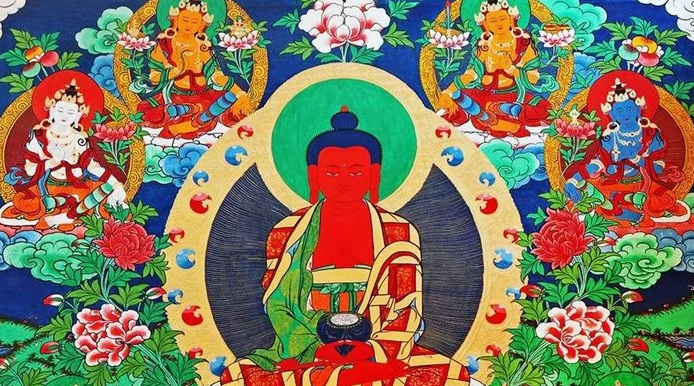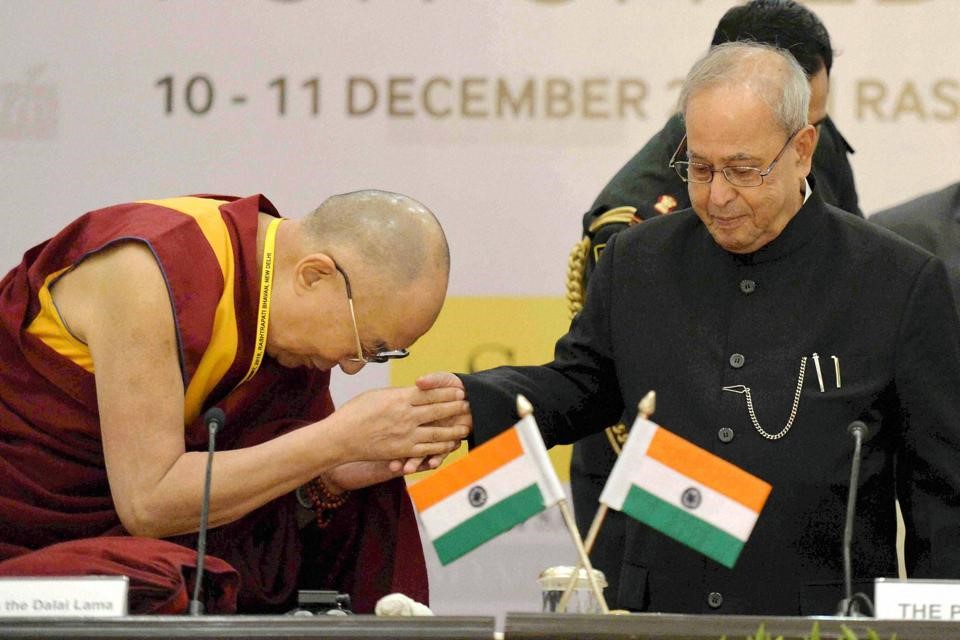30 Mar Tibetan Buddhism
Tibetan Buddhism
This article covers “Daily current affairs for UPSC “and the topic is ‘Tibetan Buddhism’ which is in the news, it covers “History” in GS-1 and “International Relations” in GS-2, the following content has relevance for UPSC.
For Prelims: Tibetan Buddhism
For Mains: GS-1, History; GS-2, International Relations
Why in the news: The Dalai Lama named a US-born Mongolian boy the tenth Khalkha Jetsun Dhampa.

Tibetan Buddhism
Introduction of Tibetan Buddhism
- Tibetan Buddhism, also known as Vajrayana Buddhism or Lamaism, is a form of Mahayana Buddhism that developed in Tibet and the surrounding regions. It incorporates elements of Indian Buddhism, Bon, and indigenous Tibetan practices and beliefs.
- Its emphasis is on tantra, which involves the use of various practices and rituals to transform ordinary experiences into spiritual ones. These practices include visualization, mantra recitation, and the use of sacred objects such as prayer beads, thangkas (religious paintings), and mandalas (geometric patterns representing the universe).
- It relies on the guidance of a spiritual teacher or guru, who provides instruction and support in the student’s spiritual development. The teacher-student relationship is considered to be a crucial element in the transmission of the teachings and practices of Tibetan Buddhism.
- Great importance on the practice of compassion and altruism, as embodied in the bodhisattva ideal of working for the benefit of all beings. The Dalai Lama, the spiritual leader of the Gelug school of Tibetan Buddhism, is perhaps the most well-known figure associated with Tibetan Buddhism in the West.

Introduction of Tibetan Buddhism
Janang Tradition
- The Janang Tradition is a form of Tibetan Buddhism that emerged in the 14th century in the Kham region of Tibet. It is named after its founder, Lama Zhang, who was also known as Janang Tashi Dorje.
- The Janang Tradition emphasizes the practice of the Great Perfection, also known as Dzogchen, which is a non-dualistic approach to spiritual practice that aims to directly experience the nature of the mind. It is considered to be the highest teaching in the Nyingma school of Tibetan Buddhism, which is one of the four main schools of Tibetan Buddhism.
- In addition to the practice of Dzogchen, the Janang Tradition also emphasizes the importance of a personal relationship with a qualified spiritual teacher, who can provide guidance and support on the spiritual path. The tradition also places importance on the practice of bodhicitta, the aspiration to attain enlightenment for the benefit of all beings.
- The Janang Tradition has been relatively unknown outside of Tibet until recently but has gained some recognition among Western students of Tibetan Buddhism in recent years.
The Concept of Hierarchy and Reincarnation tradition
- In terms of hierarchy, Tibetan Buddhism has a structured system of spiritual leaders, with the Dalai Lama being the most well-known and revered figure. Under the Dalai Lama, other high-ranking lamas serve as spiritual leaders and teachers within their respective schools or lineages. These lamas are often recognized as reincarnations of previous great masters and are believed to possess special qualities and abilities as a result.
- Reincarnation is also an important concept with the belief that when a highly realized master passes away, their consciousness can be reborn in a new body, continuing their spiritual work and benefiting others. This is known as a tulku or a reincarnate lama.
- The process of identifying a reincarnated lama involves various methods, such as divination, dreams, and visions. Once a candidate is identified, they are tested to confirm their spiritual qualities and knowledge. The recognition of a reincarnated lama is considered to be an important responsibility and is taken very seriously.
- The belief in reincarnation also extends to ordinary individuals, who are believed to be reborn after death based on their past karma and actions. The ultimate goal of spiritual practice is to attain liberation from the cycle of rebirth and achieve enlightenment.
Chinese interference
- Chinese interference in Tibetan Buddhism is a complex issue that has been ongoing for decades. After the People’s Republic of China took control of Tibet in 1950, the Chinese government began to exert influence over the practice and administration of Tibetan Buddhism.
- One of the key ways that the Chinese government has sought to interfere in Tibetan Buddhism is through the selection of reincarnate lamas or tulkus, who are traditionally identified by Tibetan Buddhist authorities. The Chinese government has attempted to exert control over this process by requiring that all reincarnate lamas be approved by the Chinese government. This has led to controversy and resistance, as many within the Tibetan Buddhist community believe that the Chinese government has no legitimate authority in this matter.
- The Chinese government has also attempted to restrict the teaching and practice of Tibetan Buddhism, particularly in the period following the 1959 Tibetan Uprising. Monasteries and other religious institutions were forcibly closed, and monks and nuns were subject to persecution and imprisonment. While restrictions have been somewhat relaxed in recent years, there are still reports of government interference in the practice of Tibetan Buddhism, particularly in areas where there is resistance to Chinese rule.
- In addition to direct interference, there are concerns that Chinese economic and development policies are harming the environment and sacred sites in Tibet, which are central to the practice of Tibetan Buddhism. This has led to criticism from both within and outside of the Tibetan Buddhist community.

Chinese Interference
India and Tibetan Buddhism
- India has played a significant role in the development and preservation of Tibetan Buddhism. Many of the key figures and teachings of Tibetan Buddhism originated in India, and Tibetan scholars and practitioners have historically looked to India as a source of inspiration and knowledge.
- In the early days, many Tibetan scholars traveled to India to study with Indian masters and to bring back important texts and teachings. These exchanges helped to shape the development of Tibetan Buddhism and fostered a deep respect for Indian Buddhist traditions and culture.
- Today, India continues to play an important role in the preservation of Tibetan Buddhism. Following the Chinese takeover of Tibet, many Tibetans fled to India and settled in Dharamsala, which has become the center of the Tibetan community in exile. The Indian government has provided support for the Tibetan community and has allowed for the establishment of numerous monasteries and educational institutions dedicated to the practice and study of Tibetan Buddhism.
Impact on India and China’s relationship
Tibetan Buddhism has had a significant impact on the relationship between India and China, with the issue of Tibet being a major point of contention between the two countries:
- India has traditionally been a supporter of the Tibetan cause, providing refuge to the Dalai Lama and the Tibetan community in exile, and advocating for the protection of Tibetan culture and religion. India has also expressed concerns about Chinese human rights abuses in Tibet and has called for greater autonomy for the Tibetan people.
- China, on the other hand, views Tibet as an integral part of its territory and has been accused of engaging in repressive policies aimed at suppressing Tibetan culture and religion. The Chinese government has also accused India of interfering in its internal affairs by supporting the Tibetan cause and has expressed concern about the activities of Tibetan exiles in India.
- As a result, the issue of Tibet has been a source of tension in the relationship between India and China. While the two countries have engaged in dialogue in an attempt to resolve their differences, progress has been slow and the issue remains unresolved.
- The impact of Tibetan Buddhism on the relationship between India and China is complex and multifaceted, with both positive and negative implications. While the issue of Tibet has been a source of tension, the practice of Tibetan Buddhism has also been a bridge between the two countries, with many Indian scholars and practitioners engaging with Tibetan Buddhism and contributing to its development and preservation.
- In recent years, there have been concerns about the impact of Chinese influence on Tibetan Buddhism in India. The Chinese government has attempted to exert control over Tibetan Buddhism both within Tibet and among the Tibetan diaspora, and there have been reports of Chinese interference in the selection of reincarnate lamas and other religious practices. Despite these challenges, the Indian government and the Tibetan community in India continue to work together to promote the practice and preservation of Tibetan Buddhism.
Way forward
The relationship between India and China, including the issue of Tibetan Buddhism, is complex and multi-faceted, and there is no single solution to resolve all the issues. However, there are several ways forward that could improve the relationship between the two countries:
- Dialogue: India and China need to continue their dialogue to resolve their differences and build mutual trust. This dialogue should be conducted at various levels, including political, cultural, and economic.
- Cultural exchanges: India and China should encourage cultural exchanges to promote understanding and cooperation. This could include exchanges between scholars and practitioners of Tibetan Buddhism, as well as exchanges in other areas such as education, science, and technology.
- Religious freedom: Both India and China should respect the religious freedom of all individuals, including those who practice Tibetan Buddhism. This would involve allowing Tibetan Buddhists to practice their religion freely, without interference or persecution.
- Development of Tibet: The Chinese government should work towards the development of Tibet in a way that respects the unique culture and religion of the Tibetan people. This would involve providing greater autonomy to Tibet and ensuring that Tibetan culture and religion are protected and preserved.
- Cooperation on global issues: India and China should work together to address global issues such as climate change and economic development. This would require building greater trust and cooperation between the two countries, which could be facilitated by working together on issues of mutual interest.
Overall, the way forward for India and China to resolve their differences on the issue of Tibetan Buddhism is through a combination of dialogue, cultural exchanges, respect for religious freedom, the development of Tibet, and cooperation on global issues.
Source:
Daily Current Affairs for UPSC Examination
UPSC examination is one of the toughest examinations in not only in India but also all over the world. For passing the UPSC examination the examinee should work hard and acquire a vast knowledge of the national and international world. For gaining huge knowledge, the aspirants should read several books as well as daily updated news through current affairs. So, Every UPSC aspirant should read daily current affairs for the UPSC exam preparation. Here, Plutus IAS provides the latest and the best daily current affairs for the UPSC examination. Also, get weekly and monthly current affairs for IAS exam preparation.
Download the PDF Now:



No Comments